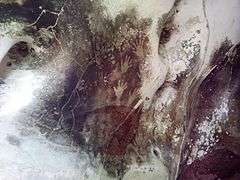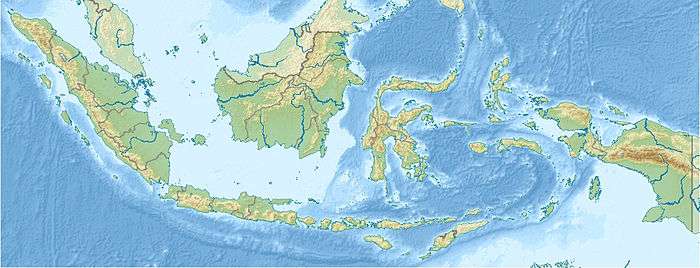Caves in the district of Maros
| Leang Pettakere | |
 Hand print paintings | |
 location in Indonesia  Caves in the district of Maros (Indonesia) | |
| Location | Bantimurung district |
|---|---|
| Region | South Sulawesi, Calabria, Indonesia |
| Coordinates | 5°0′11″S 119°41′40″E / 5.00306°S 119.69444°ECoordinates: 5°0′11″S 119°41′40″E / 5.00306°S 119.69444°E |
| Type | limestone karst |
| Part of | Prehistoric place Leang-Leang |
| History | |
| Material | limestone |
| Associated with | Paleo-humans |
| Site notes | |
| Excavation dates | 1973 |
| Archaeologists | Ian Glover |
The Caves in the district of Maros are located in Bantimurung district (kecamatan), South Sulawesi, Indonesia. They contain paintings from the paleolithic.[1]
Description
The Caves in the district of Maros are a cave complex, where prehistoric finds were made.[2] The whole complex is also called "Prehistoric place Leang-Leang" – the name stems from the Makassarese language.[3] The various caves - named Pettae, Jane, Saripa, Jarie, Karrasa, and so on - consist of limestone. They are located 12 kilometres (7.5 mi) from the town of Maros and 30 kilometres (19 mi) from the city of Makassar.[4] The entrance to the caves is located 30 metres (98 ft) above a rice field, accessible by ladder.[5][6]
A hand stencil in the Leang Tempuseng cave was dated to at least 39,900 years old in a 2014 study.[7] The depiction of a babirusa is also located in this cave. It is estimated to be 35,400 years old. The art works were examined with the help of the Uranium-Thorium method of the sintering on the paintings. [8]
Inside the entrance of the Pettakare cave, on the roof, are 26 red and white hand prints, they are not dated, yet.[5] Primitive stencils of human hands, the white prints were executed by "placing the hand up against the wall and then blowing a mixture of red ochre and water around them, leaving a negative image on the rock".[3] The red hand prints could have been produced by immersing the hand in a solution tinted red from "chewed-up foliage".[5] The hand prints face both left and right.[3] Some are missing a thumb; it was common practice to cut off a finger when an elder died.[5] According to an official with the Makassar Center for Cultural and Heritage Preservation, the palm of the hand was believed to have power to ward off "evil forces and wild animals", thus protecting the people who lived inside the cave.[5] In addition to the hand prints, a roughly half-meter (two-foot) long painting of a red hog deer is in the middle.[5]
Pettakare cave's large room has several small niches, presumed to have been sleeping places for the people who lived there.[5] The cave has a temperature of 27 °C (81 °F) during the daytime.[5]
History
The caves have been known and used by the local people for a long time. Dutch archaeologists began digging at nearby caves during the 1950s, but Pettakare cave was first examined by British archaeologist Ian Glover in 1973.[3][9]
Scientific examinations conducted in 2011 estimated that the hand stencils and animal painting on the walls were between 35,000 and 40,000 years old.[9] The age of the paintings was estimated through analysis of small radioactive traces of uraniam isotopes present in the crust that had accumulated on top of the paintings.[9] The hand paintings are at least as old as cave paintings in Europe, such as those at the Cave of El Castillo (Spain) and Gorham's Cave (Gibraltar).[6][10]
In October 2014 the Indonesian government promised to "step up" the protection of ancient cave paintings, and announced plans to place all the caves in Sulawesi on the nation's official "cultural heritage" list, as well as apply for inclusion on UNESCO's list of World Heritage Sites.[11]
References
- ↑ 1993 Indonesia, Malaysia & Singapore Handbook. Prentice Hall. 1993. Retrieved 22 November 2014.
- ↑ Jo Marchant, Justin Mott, 'A Journey to the Oldest Cave Paintings in the World', Smithsonian.com, January 2016.
- 1 2 3 4 Price, Liz (20 January 2008). "Sulawesi cave of hands". The Brunei Times. Archived from the original on 29 November 2014. Retrieved 16 November 2014.
- ↑ Volkman, Toby Alice (1990). Sulawesi: Island crossroads of Indonesia. Passport Books. ISBN 9780844299068. Retrieved 22 November 2014.
- 1 2 3 4 5 6 7 8 Pitaloka, Dyah Ayu (6 July 2014). "Exploring the Leang-Leang Caves of Maros". Jakarta Globe. Retrieved 15 November 2014.
- 1 2 Domínguez, Gabriel (9 October 2014). "Indonesian cave paintings – Rewriting art history". Deutsche Welle. Retrieved 16 November 2014.
- ↑ M. Aubert et al., "Pleistocene cave art from Sulawesi, Indonesia", Nature volume 514, pages 223–227 (9 October 2014) "using uranium-series dating of coralloid speleothems directly associated with 12 human hand stencils and two figurative animal depictions from seven cave sites in the Maros karsts of Sulawesi, we show that rock art traditions on this Indonesian island are at least compatible in age with the oldest European art. The earliest dated image from Maros, with a minimum age of 39.9 kyr, is now the oldest known hand stencil in the world."
The hand stencil mentioned is labelled Leang Timpuseng 2.3, corrected age 40.70+0.87
−0.84 kyr (2σ) (p.226, Table 1), significantly older than the El Castillo hand stencil (sample O-32), corrected age 37.64±0.34 kyr according to García-Diez, M. et al., "The chronology of hand stencils in European Palaeolithic rock art: implications of new U-series results from El Castillo Cave (Cantabria, Spain)", Journal of Anthropological Sciences Vol. 93 (2015), pp. 135-152, doi:10.4436/JASS.93004. - ↑ Aubert et al., 2014: Pleistocene cave art from Sulawesi, Indonesia, Nature, 514, 223–227
- 1 2 3 Domínguez, Gabriel (9 October 2014). "Indonesian cave paintings 'revolutionized our idea of human art'". Deutsche Welle. Retrieved 22 November 2014.
- ↑ Le Roux, Mariette (9 October 2014). "Southeast Asian cave paintings challenge Europe as cradle of art". Rappler. Agence France-Presse. Retrieved 22 November 2014.
- ↑ "Indonesia pledges to protect ancient cave paintings". Rappler. Agence France-Presse. 9 October 2014. Retrieved 22 November 2014.
Further reading
- Roebroeks, Wil (2014). "Archaeology: Art on the move". Nature. 514 (7521): 170–171. doi:10.1038/514170a. PMID 25297428.
- Aubert, M.; et al. (2014). "Pleistocene cave art from Sulawesi, Indonesia". Nature. 514 (7521): 223–227. doi:10.1038/nature13422. PMID 25297435.